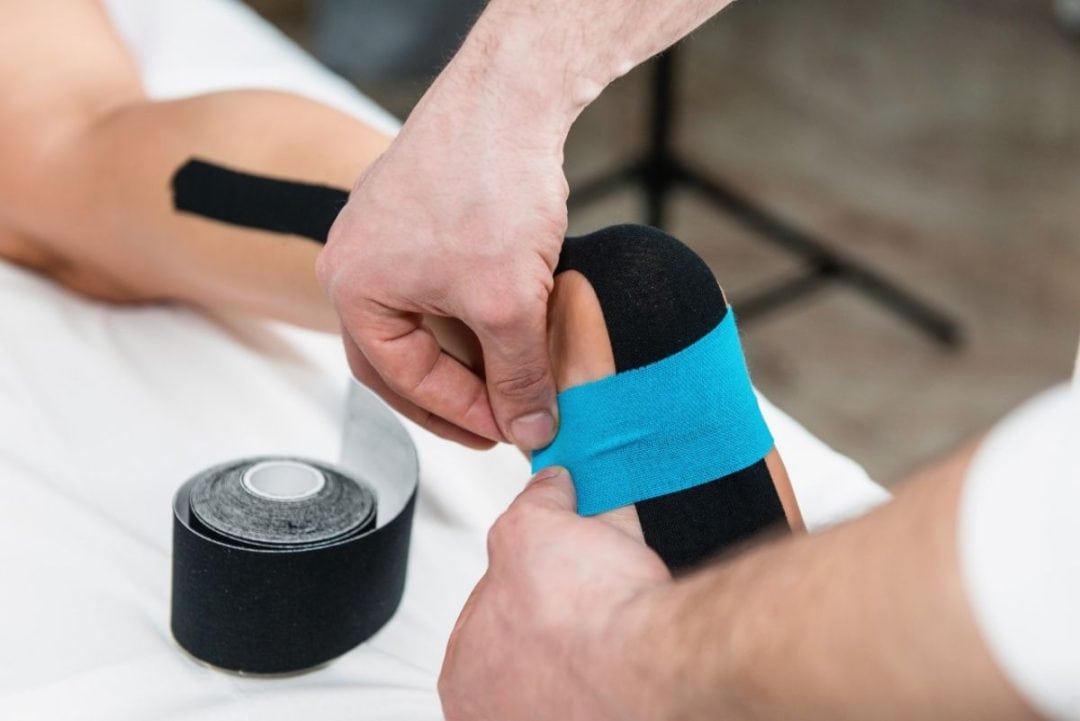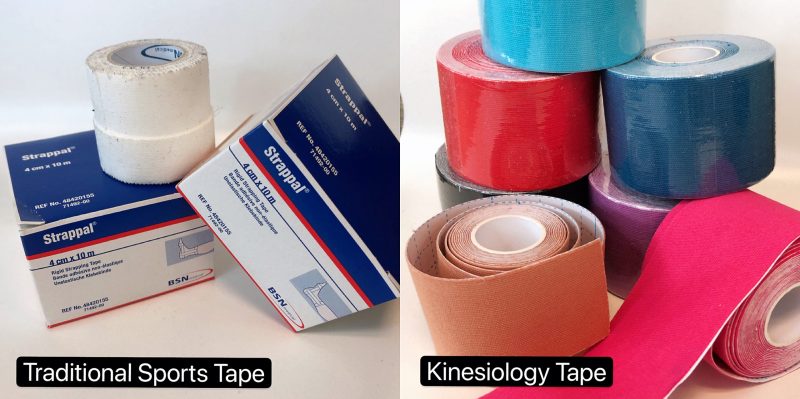
Taping has been used for a long time amongst athletes and physical therapists. It received a big boost in mainstream markets after the 2008 Summer Olympic Games in Beijing, where athletes were spotted with these colourful bands across their shoulders, down their thighs and on their shins. These adhesive strips provide superior benefits for:
- Pain relief
- Joint stability
- Reduction of injury recurrence
- Reduction of strain on injured or vulnerable muscles and tendons
Here we will take you through common taping and strapping techniques used in common foot problems and injury prevention.
Choosing The Right Kind of Tape
There are two kinds of tapes you will find in retail outlets. Rigid tape is used to support injured or unstable joints by restricting movement. Kinesio tape is recommended when you need range of motion but want additional support for sports and injury prevention.
Rigid strapping tape: known as the traditional sports tape and often comes in white or brown colour, this tape has no elasticity. It is used to provide support and stability to an injured joint or muscle group by immobilizing it. Podiatrists might also use rigid tape as a stabilising measure on patients with plantar fasciitis.
Elastic adhesive tape: also known as Kinesio tape, was developed in the 1970s. This tape can be stretched between 30% to 40% lengthwise. Kinesio tape is best suited when you need range of motion but want additional support; it mimics the elasticity of human skin which allows it to provide extra support without hindering your body’s movements. Kinesio tape is also waterproof so it can be worn during exercise and showering.
Heel Pain? Try This Out
Plantar Fasciitis, also known as heel pain is a musculoskeletal condition causing pain under the heel or into the inner arch of the foot. It is caused by a mechanical over-stretching of the ligament that supports the arch known as the plantar fascia.
We can tape the foot to help relive the pain and to take excessive load off the plantar fascia.
1. Cut two holes 2 cm from the end of tape and then tuck them between your second and third toes. Stretch the strip tightly from the ball of your foot all the way up over the back of your heel. Note the start and finish of the tape should have NO stretch while having FULL stretch in-between.
2. Place another strip of tape along the back of your heel, pulling tightly to create tension. Again leave the start and finish with no stretch while having full stretch in-between.
3. Place two more strips, one underneath the start of your arch and the other piece in the middle of the foot. Leave the start and finish of the tape with no stretch and again full stretch in-between.
Video: Strapping for Mild Plantar Fasciitis
More Aggressive Approach: Low-dye Strapping
Rigid strapping tape gives a better splinting effect compared to kinesio tape due to its stiffness; it has superior characteristics for stabilizing joints and limiting movement.
1. Stick one strip of rigid tape around the ball of your foot and another piece at the bottom of your heel
2. Apply a strip directly under your big toe joint. TWIST your big toe towards the ground before you tape it down to the back of the heel. Push the tape down into the arch to finish.
3. Repeat the same taping one more time but finish the tape slightly over to the outside of your foot.
4. Repeat the same taping but start from beneath the 2nd and 3rd toe and finish over the heel.
5. Repeat the same taping but start from beneath the 4th and 5th toe and finish over the heel.
6. Lock everything down by applying several strips transversely across the foot.
7. Taping around the side of the foot from behind the joint of the little toe to behind the big toe.
8. Repeat the same taping but at an angle so that the tape is going down towards the heel.
9. Repeat the same taping but at an angle so that the tape is going up towards the heel.
10. Putting two strips of tapes transversely across the foot to lock everything in place.
11. To put on the last piece of tape you will have to stand up, put the strip on top loosely and pad it down the foot.
Video: Low-dye Rigid Strapping
My FootDr Singapore stocks both kenesio tapes and rigid strapping tapes. We also have a variety of sandals with arch support. Find out more from our online shop: https://myfootdr.com.sg/shop/
Shoe Support is Important Too!
Wearing the right footwear will make a huge difference especially for unstable or already injured joint or tendon. If you find that the taping works well then it is likely you will benefit from wearing orthotics (custom insoles) in your shoes, as these have a similar effect on foot biomechanics. Orthotics work by controlling the position of your heel as you walk. This prevents your foot from pronating (rolling in) too early and over-stretching the plantar fascia.
The Podiatry team at my FootDr Singapore are all highly trained and skilled at holistic care management.
Call our friendly reception team today to book your appointment.




